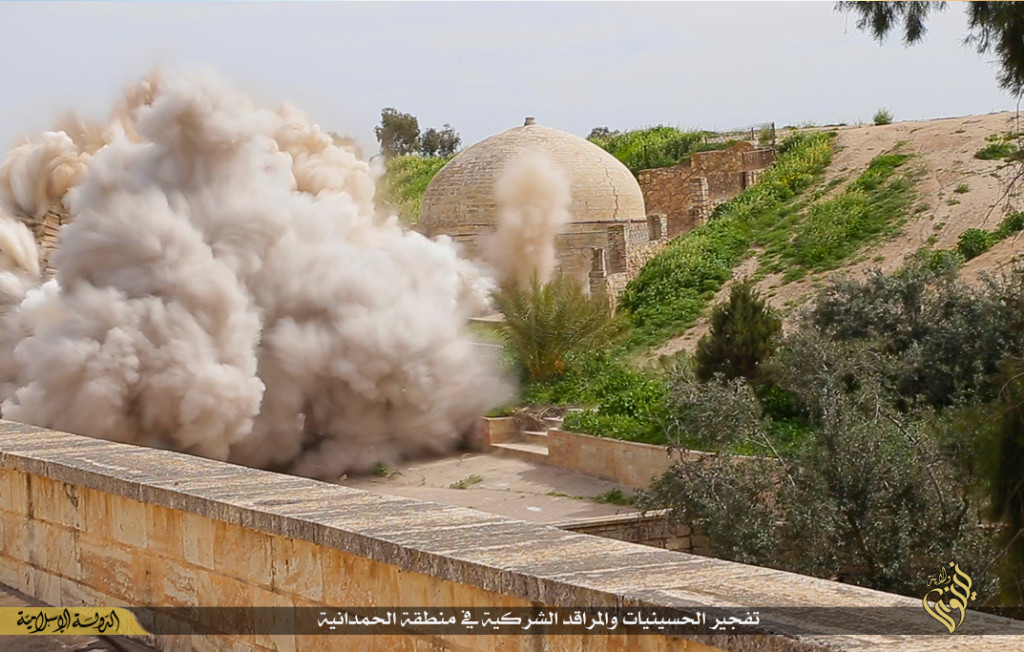Yesterday, ISIS destroyed St. Elijah’s, a 1400-year-old Christian monastery just outside of Mosul – part of their mission to obliterate history and anything that doesn’t fit into their warped version of Islam. Back in 2011, I actually visited St. Elijah’s monastery – and one that was even older, the 1700-year-old Mar Behnam Monastery and Convent – a Syriac Catholic compound also containing a chapel and two shrines and was filled with priceless artworks.

The shrines of the Christian martyrs, Behnam (left) and his sister Sarah (right), mark where the brother and sister died and had stood in various forms on this hill since the 4th century.
There had been a shrine on the hill outside of Beth Khdeda (near Mosul) since the 4th century, built by the pagan Assyrian king Senchareb as a penance for killing his son Behnam and daughter Sarah after they converted to Christianity… until March 2015, when ISIS leveled the place to the ground.

Both shrines – Mar Behnam and Marth Sarah, were blown up by ISIS on March 19, 2015.
The pictures below are all that’s left of what was once was an integral chapter in human history. Inside the chapel and shrines were examples of art and architecture rarely seen anywhere else in the world – carvings that seamlessly blended Muslim and Christian designs and one of the few Middle Eastern examples of Uigher inscriptions, left by Mongol traders and pilgrims as they made their way from China to Europe on trade routes. The walls and artwork were living history – and contained pieces from almost every century since it was built.
The buildings are now gone and the art destroyed or presumably sold off to shady people who may house them in a back room of their many mansions (yes, my imagination is getting away with me, but it’s my website!), but looking at these photographs should remind us that Iraq has been, up until recently, the cradle of civilization. It was a religiously tolerant place where Muslims, Christians, Yazidis and even Jews lived side by side until it erupted into chaos.
ALL ART AND ARCHITECTURE PICS AFTER THE JUMP!
Nota Bene: This was 4.5 years ago, before I had a decent camera and any patience, so forgive the quality.

The entrance to Mar Behnam (St. Behnam) Monastery and Convent.
Back in the day, intrepid tourists could actually roll up in a bus and go inside. Situated outside of Mosul, it was mildly terrifying to get to – but worth it once you were there.

I visited Mar Behnam in 2011, pre-ISIS and its destruction.

Inside the walls of the Mar Behnam Monastery and Convent in Iraq.
Priests and nuns used to live on the upper floors of the buildings that surrounded a peaceful courtyard.

A relief on the chapel inside the Mar Behnam Monastery and Convent.
This relief includes the Muslim crescent, the Jewish star, the Christian cross, Arabic art and a form of ancient writing.

A statue of Mary used to stand watch outside the chapel at the Mar Behnam Monastery and Convent in Iraq.

In the basement of the Mr Behnam Church were enameled and glazed carvings.
Art like this was most likely removed by ISIS and sold before they blew up the building.

The ceilings of Mar Behnam were intricately carved and held traces of blue paint.

An intricately adorned Bible inside Mar Behnam.
This ornate Bible – covered in real gold and gems and hand painted – was also most likely sold by ISIS to fund its insanity.

A statue/relief of Mar Behnam (Saint Behnam) inside the chapel.

A 12th century painting of Mary and Jesus in the chapel.

This depiction of Mar Behnam riding into battle and trampling his enemies was on the Western wall of the chapel.

A small chapel inside the church.

A Uigher inscription is carved above where Behnam and Sarah were buried. The priest of Mar Behnam – presumably dead or in exile – is the man in the robe. I don’t know what happened to our guards (left) and guide, Mohammed. Hopefully they are safe.

In the basement were recently excavated tombs which had inscriptions over the doorway, including a cross as the tree of life.

The lion was bad, so he got put in the corner.

Get a load of that solid gold, bejeweled, ancient necklace the priest is wearing – I’m betting he took it with him if he escaped.

A cross carved into tree in the courtyard of the Mar Behnam Monastery compound. The tree was said to be hundreds of years old.

Thank you for sharing your pictures of the rare, now lost, art images from the monastery ISIS demolished last year. It sickens me to think of this. Thank goodness for photographs.
Pingback: Rare Images of Art From Inside Iraq’s Oldest Monastery — Now Gone | Vus Times
Pingback: Rare Images of Art From Inside Iraq's Oldest Monastery - Now Gone - Democratsnewz